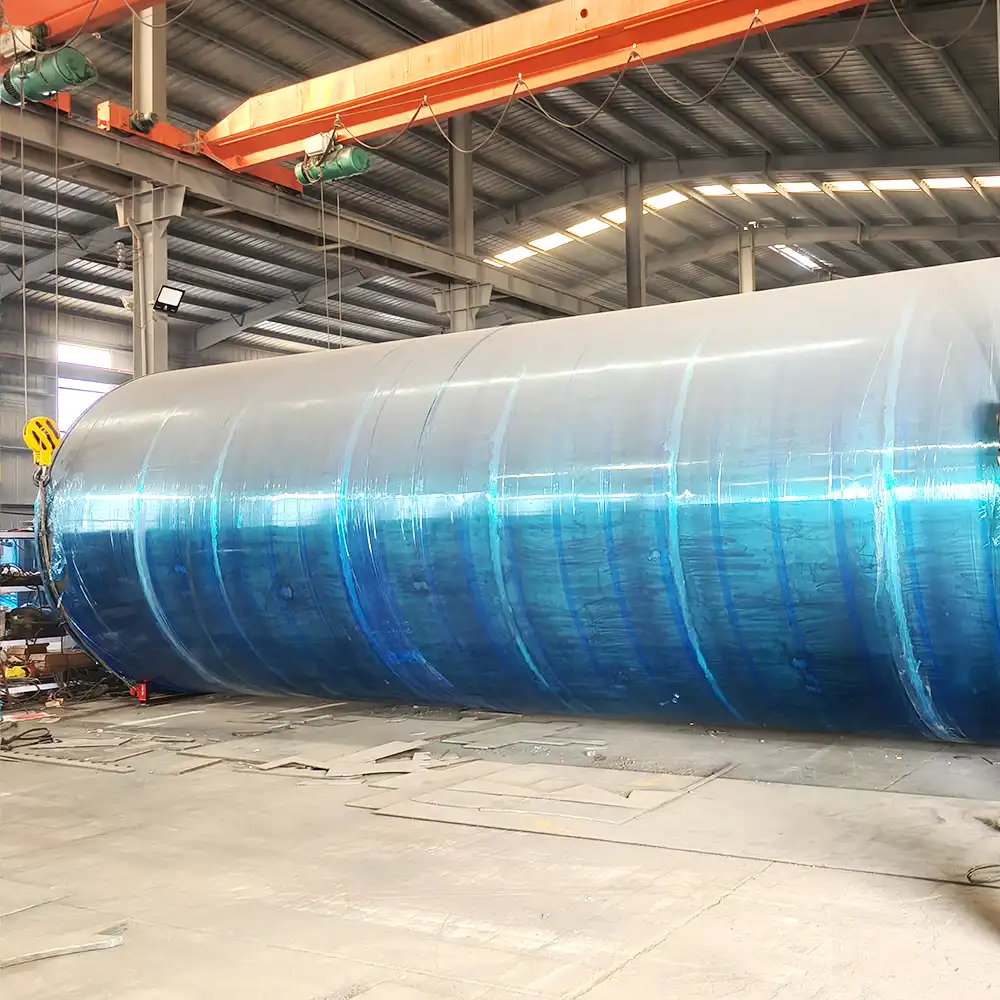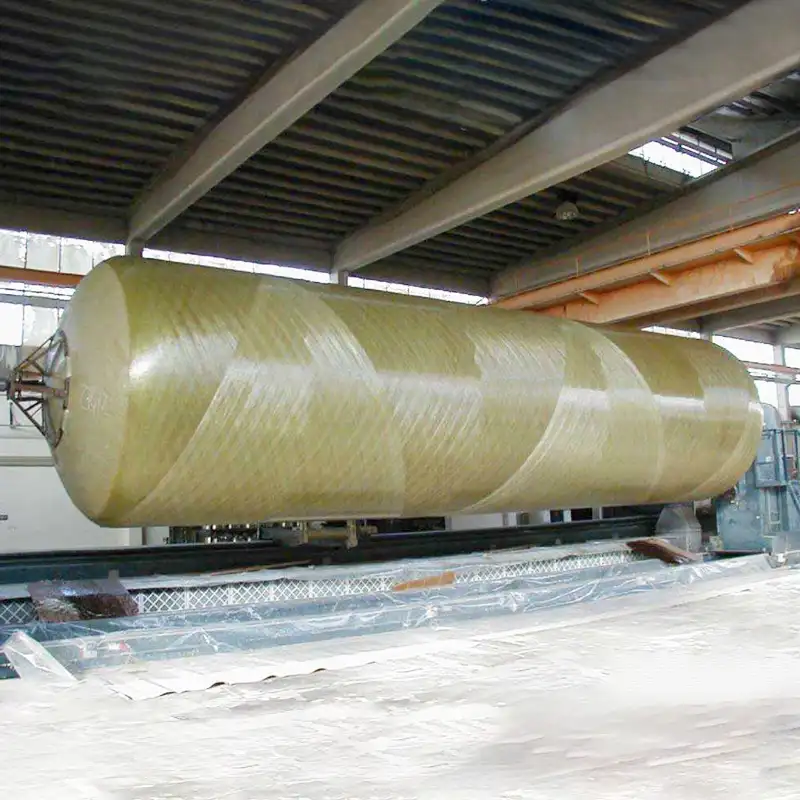Why are winding pattern errors a concern in FRP filament winding?
Precise placement of fibers is crucial for the strength of FRP parts. Mistakes in the winding pattern can cause weak areas, overlaps, or gaps. These flaws ultimately lower the product’s ability to bear weight and its long-term endurance. This section explains the dangers of pattern mistakes. It also shows how modern machines reduce them using automatic controls.
Structural weaknesses from pattern deviations
Keeping fiber placement exact is key for the final structure’s strength. Mistakes in the pattern can lead to uneven force distribution, gaps, or overlaps. These weaken the structure. Machines must be set up accurately. They need to manage the winding angle and speed well. These factors greatly affect the final product’s mechanical properties. If not handled correctly, such mistakes may cause parts to break under stress or wear out too soon.
Programmable winding path controls
Advanced machines solve these issues using programmable control systems. These systems ensure the fiber path stays consistent.
CNC‐based mandrel rotation
Operators input the product’s winding settings. Then, the computer automatically designs the tank’s fiber paths. Next, it controls both the mandrel’s rotation and the trolley’s movement. This combination ensures accurate fiber placement during the entire production process.
Multi-axis control algorithms
Newer systems use multi-axis algorithms. These synchronize the mandrel’s spin with the carriage’s travel. This coordination allows for complex shapes. It also ensures uniform fiber angles. This reduces human mistakes and improves consistency.
Aoliande tackles this problem by integrating computer-controlled adding mortar-winding machine technology. Their systems automatically adjust winding linearity based on input settings. This removes variations caused by manual handling.
What issues arise from uneven fiber tension in FRP filament winding?
Keeping fiber tension steady is essential for making uniform, strong composites. Changes in tension can cause problems like fiber distortion, areas with too much resin, or gaps. These weaken the final part. Here, we look at the impact of inconsistent tension. We also examine machine-based answers that guarantee the best fiber handling.
Effects on composite strength and appearance
Uneven tension can cause twisted fibers, areas rich in resin, or gaps between layers. These faults reduce mechanical strength. They can also affect how the product looks. Controlling fiber tension is also very important in filament winding. Keeping tension constant ensures the composite structure is uniform. This directly affects the strength and endurance of the finished product.
Machine-based tension control solutions
Maintaining even fiber tension is critical in FRP filament winding. It prevents structural weaknesses and ensures consistent product quality. Modern machines use automatic systems to manage tension actively. This minimizes flaws caused by uneven stress spread.
Closed-loop feedback systems
Advanced machines use closed-loop feedback systems. These watch and adjust tension actively during operation. The systems spot changes in real time. Then, they fix them immediately.
Automated tension rollers
Automatic rollers apply steady pressure across all fiber strands. This maintains even tension despite changes in speed or direction.
Aoliande’s equipment has a roving framework and tension controller. This allows exact fiber management. It improves structural consistency in large FRP tanks.
How do resin distribution inconsistencies impact filament winding quality?
Proper resin soaking is necessary for a strong, flawless composite structure. Uneven resin application can lead to dry spots or too much saturation. This causes separation between layers or early failure. This section studies the results of resin irregularities. It also covers the advanced machine technologies that ensure exact and even spread.
Consequences of improper resin impregnation
Wrong resin levels can cause dry spots or overly wet areas inside the laminate. These problems create weak points. These weak points might cause layers to separate or the part to fail under pressure. Any variation can lead to issues like gaps between fiber layers. It can also cause uneven resin spread. Both can harm the component’s soundness.
Advanced machine resin metering techniques
Proper resin soaking is essential for the best composite strength. It avoids problems like dry spots or resin-heavy zones. Modern filament winding machines use accurate dispensing technologies. They also use real-time watching. This ensures resin spreads evenly through all the fiber layers.
Precision resin pumps
Machines have metered pumps. These deliver the exact resin amount per cycle. This guarantees even soaking across all fibers.
Real-time viscosity monitoring
Sensors check resin viscosity constantly during production. Adjustments happen automatically. This keeps the flow properties ideal.
Aoliande’s solution includes a resin supply system and resin immersing system. These work together for steady soaking. They tackle one of the most important challenges in making high-quality FRP products.
In what ways can mandrel misalignment disrupt the winding process?
Mandrel alignment is critical for making geometrically correct FRP parts. Misalignment can cause off-center winding, size inaccuracies, and structural weaknesses. This is especially bad for pressure vessels. We look at how automated alignment systems in modern machines stop these problems. They also boost production accuracy.
Distortions and dimensional inaccuracies
Mandrel misalignment leads to off-center windings. This causes shape changes affecting both use and looks. This misalignment is especially troublesome for pressure vessels. There, being perfectly round is crucial for performance.
Automated alignment and correction features
Mandrel misalignment can cause shape mistakes and weakened structures. To reduce this, advanced winding machines use laser-guided positioning. They also have adaptive fixtures. These automatically find and fix deviations during production.
Laser-guided positioning
Laser systems offer real-time alignment checking before each cycle starts. This guarantees accuracy throughout production runs.
Adaptive mandrel fixtures
These fixtures adjust automatically using sensor feedback. They correct position errors without stopping work.
Aoliande’s vertical site machines have a rotating platform and vertical post. These are powered by a hydraulic system. They offer stable support for big mandrels. This reduces alignment mistakes during high-volume production.
How does inadequate tension monitoring lead to production defects?
Unmonitored fiber tension can cause problems like slipping, breaking, or uneven layers. This leads to expensive rework or waste. This section highlights the importance of real-time tension watching. It also explores the built-in sensor systems. These allow proactive flaw prevention in filament winding.
Types of defects linked to poor monitoring
Without trustworthy watching systems, issues like fiber slip or break might be missed. They are often only found after production. These flaws usually need costly rework. Sometimes entire components must be thrown away.
Integrated monitoring and alarm systems
Inconsistent tension watching can result in hidden flaws. These include fiber slipping or breaking. Top-tier machines include sensor networks and predictive analytics. These give real-time feedback. This allows instant changes and prevents expensive production errors.
Sensor networks for tension measurement
Sensors placed throughout the machine track tension values live across all strands during winding. Variations set off alerts or automatic fixes through the control software.
Predictive maintenance alerts
Smart analytics predict when parts like rollers or motors might fail. They do this by spotting abnormal tension readings. This allows action before flaws happen.
Aoliande builds in these abilities through its computer control system and power distribution box. This allows automatic supervision of key settings like fiber tension. It ensures ongoing quality checks during long production cycles.
Who is Hebei Aoliande Chemical Equipment Co., LTD.?

As a top maker of FRP filament winding machines, Hebei Aoliande Chemical Equipment Co., Ltd. combines years of know-how with advanced automation. They deliver high-performance answers. This section gives an overview of their new technologies. It also covers their role in tackling major industry problems.
Company overview and experience
Hebei Aoliande Chemical Equipment Co., LTD specializes in making advanced FRP filament winding machines. They have decades of experience serving worldwide industries. These include petrochemical, water treatment, farming, and building sectors. Their solutions focus on automation-driven efficiency. They also emphasize long life and accurate engineering.
Key features of their FRP filament winding machines
Their main models include horizontal RPM pipe lines and vertical site-winding machines. These can handle diameters from 4m up to 25m. Pipes made by their adding mortar-winding machine cost less. They are also stiffer because mortar is added. This does not harm the leak-proof layer or the structure layer. Using Taiwan-made industrial computers ensures strong automation. It also offers flexibility for different uses. These range from tanks to pressure vessels. Annual output can reach 5000 tons per line.
Conclusion
The top 5 problems in FRP filament winding are pattern mistakes, uneven fiber tension, inconsistent resin use, mandrel misalignment, and bad tension monitoring. These can badly harm product quality if ignored. However, advanced machines, like those from Hebei Aoliande Chemical Equipment Co., LTD., offer built-in solutions. These include computer-controlled motion systems, smart feedback loops, exact metering units, hydraulic supports, and predictive maintenance tools. These improvements solve long-standing manufacturing issues. They also raise productivity standards across industries needing high-performance composites.
FAQs
What maintenance practices ensure optimal machine performance?
Regular sensor calibration is important. Lubricating moving parts helps too. Updating control system software is essential. Inspection routines also prevent unexpected stops. These practices also help machines last longer.
How do advanced machines adapt to different FRP materials?
Modern machines let operators input settings specific to the material. These include curing time or viscosity range. Then, the automation logic adjusts accordingly. This ensures they work well with various resins and fibers.
Can filament winding machines integrate with enterprise systems?
Yes. Many newer models support connection with MES (Manufacturing Execution Systems) or ERP platforms. They do this using standard methods like OPC UA. This allows smooth production tracking and resource planning.
What training is required to operate these advanced winding machines?
Operators usually need technical training. They must learn CAD software for pattern design. Hands-on experience with machine interfaces is also needed. Makers often give initial setup help. They also offer ongoing support packages.






